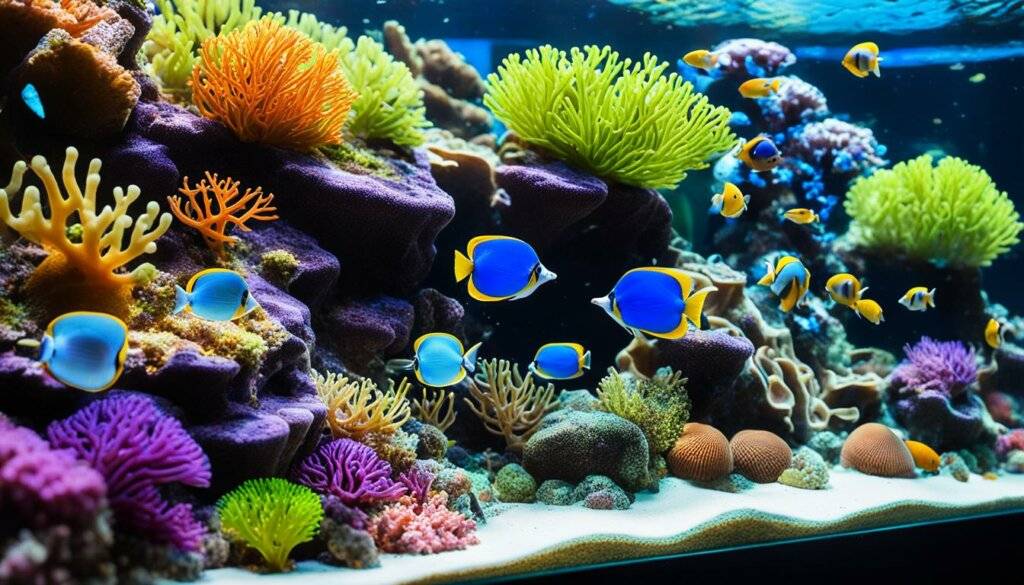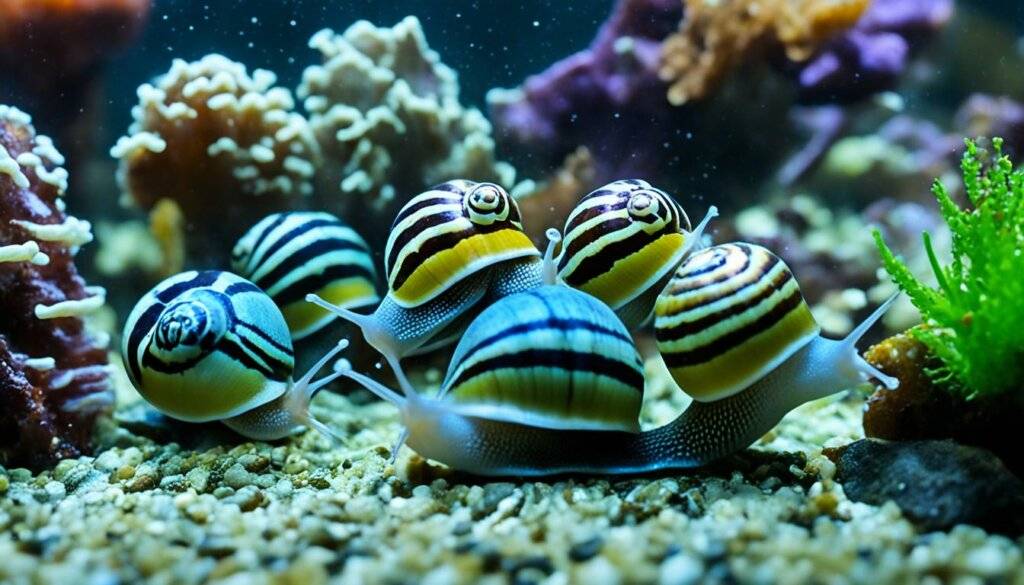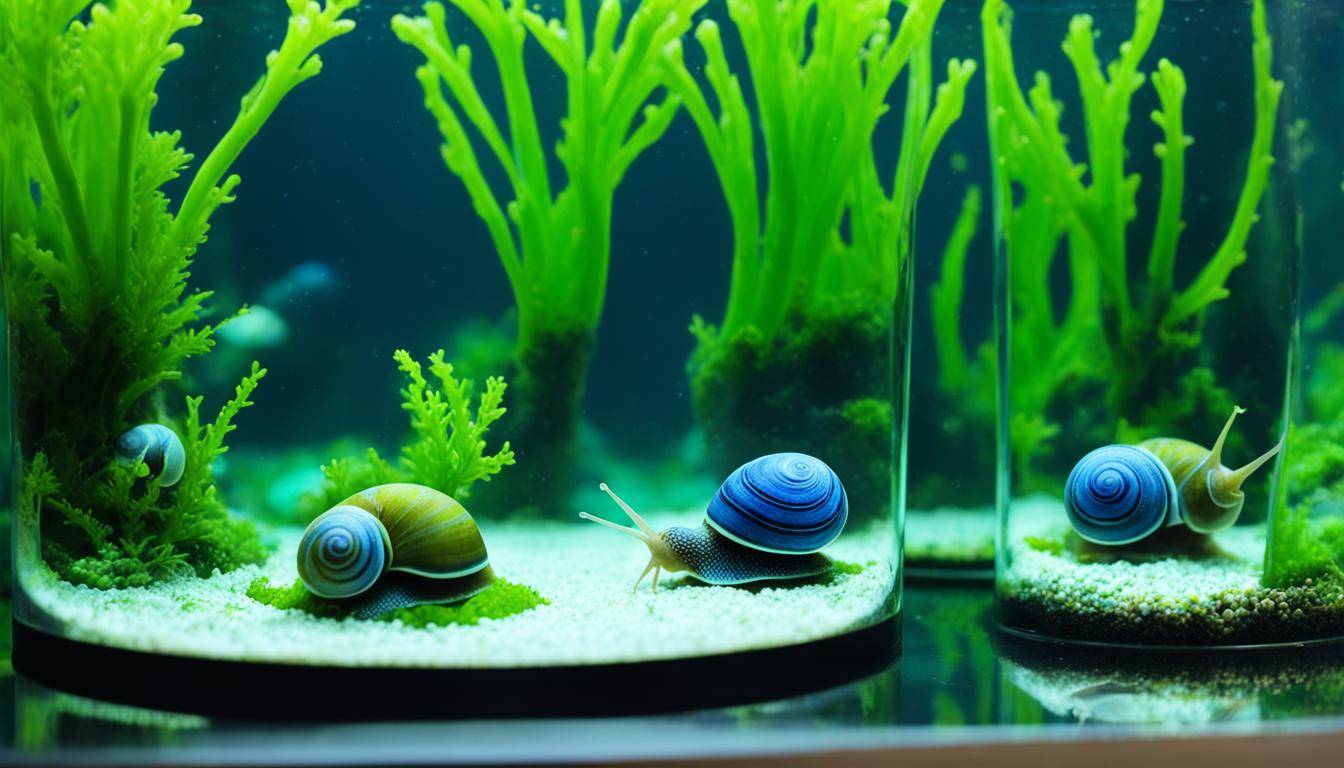Imagine setting up your dream aquarium with perfect plants and fish. But soon, you see green film on the glass. Also, algae cover the rocks and sand. Your beautiful aquarium is losing its charm.
Don’t panic and use harsh chemicals. There is a natural solution – ramshorn snails. These tiny creatures are true heroes. They eat up algae, saving your aquarium from dull looks.
Ramshorn snails have pretty spiral shells. They are small but very effective cleaners. They love algae and quickly eat it. They not only control algae but also keep the ecosystem balanced.
Choosing these “little heroes” means less hard work for you. They offer a green and healthy way to clean your aquarium. Let’s explore how these snails are key to a vibrant aquatic environment.
The Importance of Cleanup Crew in Aquariums
Keeping the aquarium clean and healthy is top priority. The aquarium cleanup crew plays a key role. Creatures like ramshorn snails provide essential ecological services. They keep the aquarium ecosystem healthy.
This crew’s main job is to stop the growth of unwanted stuff. They eat and control things like detritus, macroalgae, planktonic algae, and biofilms. This stops pest algae blooms and keeps the water right for other creatures.
What’s cool is, the cleanup crew helps corals and others too. They keep algae and nutrients in check. This helps create a balanced and beautiful aquarium.
“The role of a cleanup crew in aquariums is like nature’s cleaners. They keep the place clean and healthy.”
Having a good cleanup crew means less algae and better water. It also means you don’t need as many chemicals. This is better for the environment.
In the end, a diverse and efficient cleanup crew is crucial for the aquarium. They control algae, balance the water, and live well with others. They make a healthy and harmonious environment.
| Benefits of Cleanup Crew in Aquariums | Cleanup Crew Organisms |
|---|---|
| Regulates growth of detritus, macroalgae, planktonic algae, and biofilms | Ramshorn snails, hermit crabs, shrimp, sea urchins |
| Prevents pest algae blooms | Snails, sea urchins |
| Promotes balanced water chemistry | Snails, shrimp |
| Symbiotic relationship with corals and other organisms | All members of the cleanup crew |
| Reduces reliance on chemical interventions | All members of the cleanup crew |
The Role of Cleanup Crew in Reef Aquariums
In a reef aquarium, cleanup crew organisms are key to a healthy environment. They fight algae on glass, sand, and rocks. This keeps the surroundings beautiful for corals and other animals. A variety of cleanup crew species keeps algae in balance. This improves biodiversity, making the aquarium a better home for its residents.
The Cleanup Crew Agents
Many invertebrates and fish work to control algae in reef tanks. Turbo snails, cerith snails, and astrea snails are top-notch at getting rid of algae. Hermit crabs clean up the floor, eating algae and food bits. Peppermint shrimps tackle pests like aptasia anemones. Sea urchins and starfish, such as the sand-sifting starfish, help keep away algae and detritus.
Together, these agents keep the tank clean and perfect for every creature.

-
Save
Enhancing Biodiversity
Cleanup crews managing algae growth really help the aquarium’s biodiversity. Too much algae is bad for corals and other animals. It takes away their nutrients and sunlight. The cleanup crew makes the aquarium a good place for life to grow.
“In a well-maintained reef aquarium, the cleanup crew serves as an essential component for achieving a balanced and visually appealing ecosystem.” – Marine Aquarium Magazine
The Cost of Cleanup Crew in the Reef Aquarium Industry
The need for cleanup crew organisms is increasing in the reef aquarium world. Yet, this demand has made prices go up. This is tough on those who keep aquariums and the businesses that serve them. The costs go up because it’s harder to collect these organisms from the wild, there are more costs in shipping them, and the rules to protect the environment have gotten stricter.
In the past, people would often get their cleanup crews from the wild. But now, there are rules to keep the natural world safe and healthy. These rules limit what we can take from the wild. That means some species are not as easy to find, making them more expensive. So, some people and businesses are looking for new ways to meet the growing need for these organisms.
That’s where aquaculture comes in. It helps keep the prices steady and ensures we always have these helpful organisms. With aquaculture, we can grow these species in places we can control. This way, we don’t have to just take them from the wild. It’s good for the environment, and it means more affordable prices for everyone.
Aquaculture also lets us learn more about these organisms. With this knowledge, we can create better versions of them for our aquariums. This means they can do their job better in keeping the water healthy.
“Aquaculture helps make cleanup crew organisms more available and affordable. This is good for the whole reef aquarium community.”
The Benefits of Aquacultured Cleanup Crew
By growing cleanup crew organisms, whether it’s plants or animals, we get a lot of good things. One big benefit is that they are always available, no matter the season. This makes keeping an aquarium easier and more enjoyable.
Also, we can choose to grow them in ways that make them very good at certain jobs. For instance, some snails can be made to really like eating specific types of algae. This helps keep the water clean with less work from you.
What’s great is we help protect the oceans, too. By not taking from the wild so much, we are being kinder to ocean life. This is a small way we can help keep our oceans healthy and full of life.
“Growing cleanup crew organisms is good for your wallet, the environment, and your aquarium. It’s a win-win for everyone.”
Comparison of Cleanup Crew Costs
To show how prices compare, let’s look at cost differences between getting these organisms from the wild and growing them ourselves:
| Cleanup Crew Organism | Cost (Wild Collection) | Cost (Aquacultured) |
|---|---|---|
| Ramshorn Snails | $XX.XX per snail | $XX.XX per snail |
| Hermit Crabs | $XX.XX per crab | $XX.XX per crab |
| Peppermint Shrimps | $XX.XX per shrimp | $XX.XX per shrimp |
| Sea Urchins | $XX.XX per urchin | $XX.XX per urchin |
*Prices are based on averages and can change based on where you are and what’s available.
The table shows that aquacultured organisms are just as good as wild ones. The prices are not that different. This shows we are making progress in making them affordable. Prices staying steady means we can all enjoy having these organisms in our aquariums. This is very good for the health of our aquariums.
Moving toward aquaculture isn’t just good for us. It’s also good for the oceans. By caring for the ocean’s creatures this way, we do our part in keeping the oceans healthy. This helps save the ocean’s beauty for the future.

-
Save
The Benefits of Aquacultured Cleanup Crew
Aquacultured cleanup crew help keep aquariums clean and balanced. They are available all year and cost less, making aquarium cleaning more effective. This means better maintenance for your aquarium.
Aquarists can breed these organisms to be more efficient at cleaning. This targeted approach means they live longer and eat specific pests. Such breeding improves overall maintenance and the cost.
“Aquacultured cleanup crew organisms can be selectively bred to live longer, consume specific pests, and enhance the overall efficiency of aquarium maintenance.”
Aquacultured crew reduce the need for catching wild species. This helps the environment by using less from nature. Sustainability and ethical practices are promoted by using aquacultured organisms.
Now, let’s see the difference between wild and aquacultured cleanup crews:
| Wild Collection | Aquaculture | |
|---|---|---|
| Availability | Subject to seasonal fluctuations | Consistent throughout the year |
| Price | Higher due to limited supply and collection costs | Lower due to controlled production and availability |
| Efficiency | Natural variability | Selective breeding for improved performance |
| Sustainability | Relies on wild populations | Reduces strain on natural populations |
Table: A comparison between wild collection and aquaculture of cleanup crew organisms.
Choosing aquacultured cleanup crew provides many benefits. It stabilizes prices, keeps them available, and makes them work better. It’s good for your aquarium and for the future of the hobby.
Trustworthy and Sustainable Cleanup Crew Solutions
Getting your cleanup crew from trusted, eco-conscious suppliers is key. This ensures they work well, are of high quality, and are gentle on the planet.
Embracing Mulm in Freshwater Aquariums
Mulm is the organic layer in the bottom of aquariums. It helps keep the water healthy. It’s like a natural fertilizer for plants. It also helps with water clarity and is good for small creatures.
Mulm is made of old plant parts, food pieces, and fish waste. It breaks down to give plants food, helping them grow. This makes the aquarium look great and keeps everything in balance.
Mulm is more than just plant food, though. It’s a home for good bacteria. These bacteria clean the water by turning harmful waste into something less harmful. This keeps the water safe for fish and plants.
Mulm is also a cozy spot for tiny creatures like worms and shrimp. They add variety to the tank and help clean up. This way, the aquarium stays healthy and vibrant.
To make the most out of mulm, you need to keep it in check. Too much can spoil the water and make it hard for plants and fish to live.. By keeping the tank clean through regular checks, you can avoid problems.
The Benefits of Mulm in Freshwater Aquariums:
- Provides natural fertilizer for aquarium plants
- Supplies essential nutrients for plant growth
- Supports beneficial bacteria for biological filtration
- Creates a hiding place for small invertebrates
- Contributes to water clarity and stability
Striking the right balance with mulm can make your aquarium flourish. With its many uses for plants, beneficial bacteria, and creatures, mulm turns tank-keeping into a sustainable hobby. It boosts the health and beauty of your aquarium.
Conclusion
Ramshorn snails and mulm are crucial for keeping aquariums clean. They help control algae, recycle nutrients, and filter the water. This leads to high-quality conditions for fish and other aquatic life.
Using these natural cleaners means less work for the aquarium owner. The system mimics nature and stays in balance. It reduces the need for constant manual upkeep.
The aquaculture industry has made it easier and cheaper to get these cleanup species. Through their actions, caring for an aquarium becomes more sustainable. This helps protect the environment and the creatures living in your aquarium.
Thus, ramshorn snails and mulm are key players in aquarium care. They keep the ecosystem balanced and make it look good. They are essential for a healthy and long-lasting aquarium environment.
